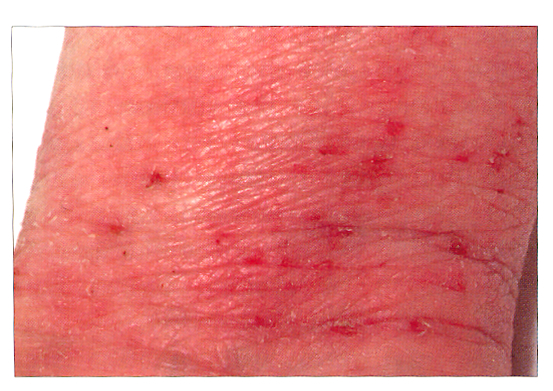Three-in-one: the hydrocolloidal gel dressing

When chronic atopic eczema is localized, perhaps because a particular part of the body is a favourite place for scratching and rubbing (see wrist above), it may be possible to achieve successful treatment using the The Combined Approach through the use of extra thin hydrocolloidal dressings (Granuflex; Duoderm) over an application of topical steroid.
These self-adhesive transparent and flexible dressings are otherwise used in treating minor burns, dressing wounds and in stoma care. Because air permeates through them, they do not leave the skin macerated. They do provide sufficient insulation against excessive water loss to prevent the underlying skin from drying out: an area of eczema covered with extra-thin hydrocolloidal gel dressing does not require emollient. The dressing itself acts as Level 1 of The Combined Approach, for the time it is in place.
When used in this way, as part of The Combined Approach, it has the added advantage of providing occlusion under which topical steroid is significantly more effective as an anti-inflammatory treatment: like growing tomatoes under glass, the occlusion magnifies the potency of the topical steroid. If the skin is particularly thick, one application of topical steroid per day under occlusion is recommended, but this frequency needs supervision. The use of less often applications of topical steroid under occlusion can be effective with less thickened skin, providing optimal Level 2 treatment.
Finally, the dressing also protects the occluded skin from scratching, rubbing and picking. With the dressing in place, habit reversal - Level 3 - is not required for the protected area. The natural healing process of the skin, with normal skin hydration provided by the dressing, and the magnified anti-inflammatory steroid effect, brings about successful treatment at all three levels of The Combined Approach, with less frequent application of topical steroid.
Tip: if the topical steroid is not being used daily, the dressings may remain in place, but they usually need replacing every two or three days.
